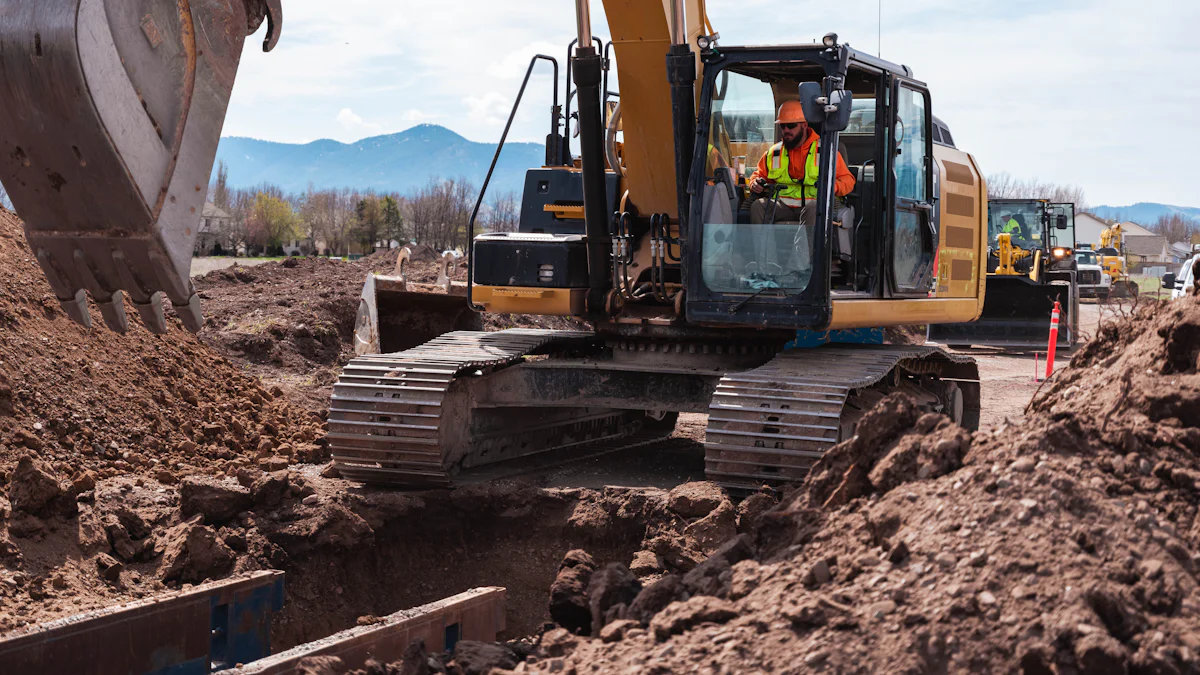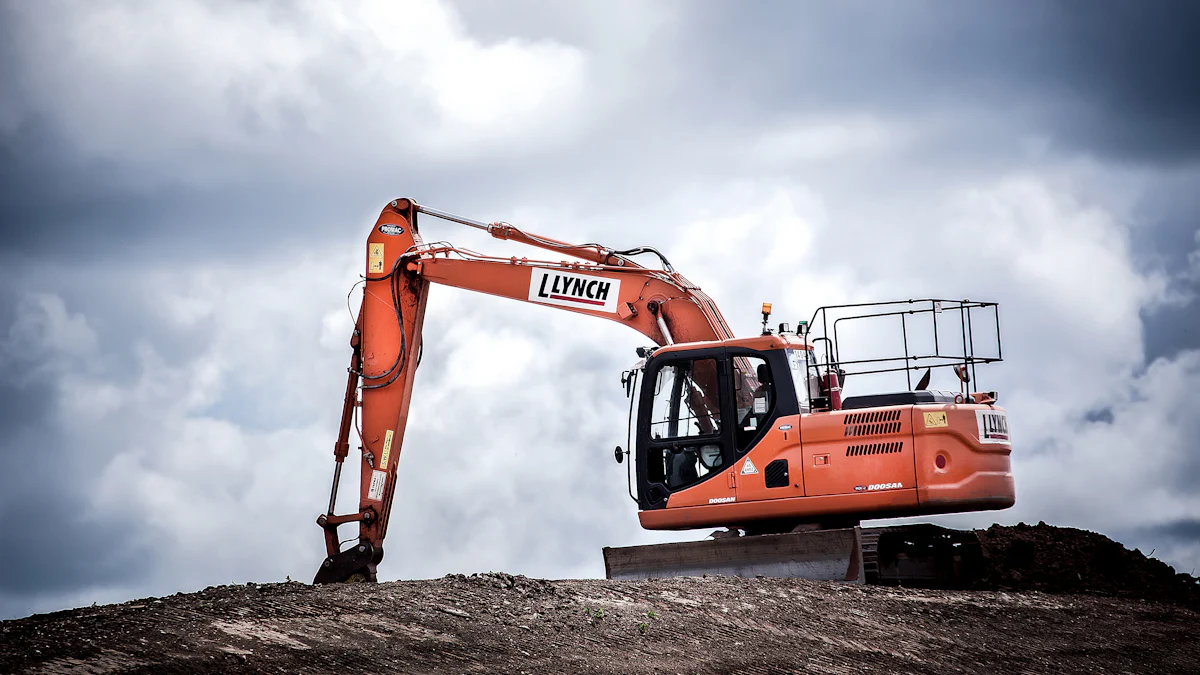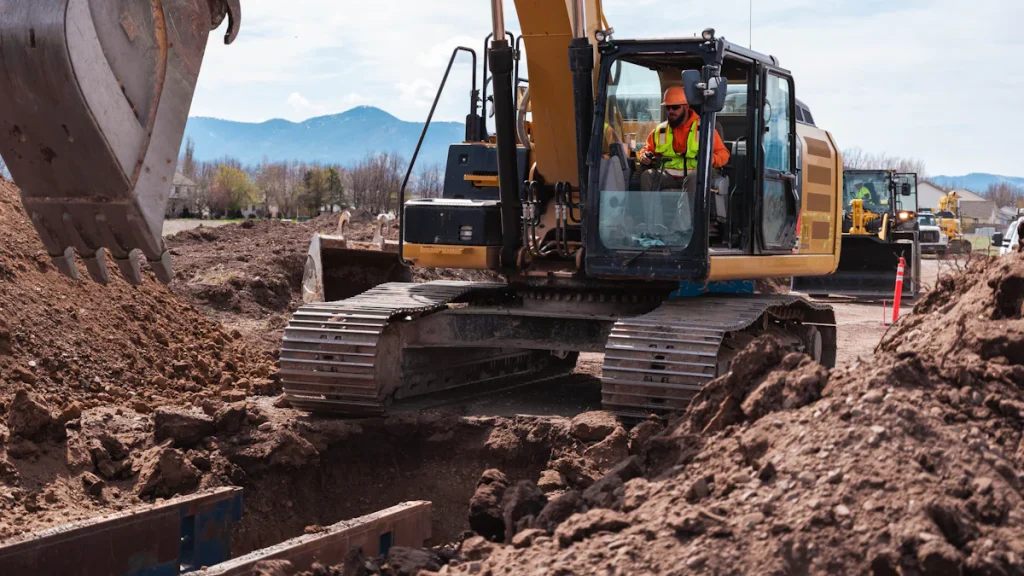
An excavator catalogue serves as a powerful tool to simplify your equipment selection process. It consolidates critical details like engine performance, operating weight, and fuel efficiency into one accessible resource. This centralization allows you to quickly compare models without sifting through scattered information. For instance, studies show that nearly 60% of an excavator’s fuel energy is consumed by its engine system, making fuel efficiency a key factor to evaluate. By focusing on such specifications, you save valuable time while ensuring the machine aligns with your needs. Knowing what to prioritize in the catalogue enhances its value even further.
Key Takeaways
An excavator catalogue centralizes critical information, allowing for quick access to specifications like engine performance and fuel efficiency, saving you hours of research.
Using a well-organized catalogue simplifies model comparisons, enabling you to evaluate key features side by side and make informed decisions without wasting time.
Prioritize essential specifications such as engine power, operating weight, and digging depth to ensure the excavator meets your project requirements effectively.
Consider fuel efficiency and environmental impact when selecting models, as these factors can significantly reduce operational costs and contribute to sustainability.
Utilize filters and search tools in the catalogue to narrow down options based on your specific needs, making the selection process more efficient.
Consulting experts or dealers can provide valuable insights and help you avoid common mistakes, ensuring you choose the right equipment for your projects.
Focus on long-term value rather than just initial price; consider maintenance costs and overall performance to maximize your investment.
The Role of an Excavator Catalogue in Saving Time
Centralized Information for Quick Access
An excavator catalogue serves as a one-stop resource for all the critical details you need. Instead of searching multiple websites or contacting various dealers, you can find everything in one place. This includes specifications like engine power, operating weight, and fuel efficiency. For example, studies reveal that nearly 60% of an excavator’s fuel energy is consumed by its engine system. Having this information readily available helps you focus on models that meet your operational needs. A centralized catalogue eliminates unnecessary back-and-forth, saving you hours of research.
Simplifying Model Comparisons
Comparing excavator models becomes much easier with a well-organized catalogue. You can quickly evaluate key features side by side, such as digging depth, hydraulic performance, and attachment compatibility. For instance, the hydraulic system alone can account for up to 17% of total fuel energy consumption during operations. By reviewing these details in a structured format, you can identify which models offer better efficiency and performance. This streamlined comparison process ensures you make informed decisions without wasting time on irrelevant options.
Reducing Research Time with Comprehensive Details
A comprehensive excavator catalogue provides all the information you need to make a decision. It includes data on fuel efficiency, environmental impact, and maintenance requirements. For example, only about 10% of an excavator’s fuel energy is used for actual work, while the rest is consumed by auxiliary systems. Knowing this allows you to prioritize models with advanced technology that minimizes energy loss. With everything laid out clearly, you spend less time piecing together information from different sources and more time focusing on what matters most—choosing the right equipment.
Key Specifications to Evaluate in an Excavator Catalogue
Engine Power and Performance Metrics
Engine power plays a critical role in determining an excavator’s efficiency and productivity. When reviewing an excavator catalogue, you should focus on the horsepower and torque specifications. These metrics directly impact the machine’s ability to handle heavy-duty tasks. For instance, the EC550E boasts the highest engine power in its class, delivering exceptional swing torque and tractive force. This makes it ideal for large-scale excavation projects. Similarly, the Cat® 395 Excavator offers 10% more swing torque and stick force compared to its predecessor, ensuring faster cycle times and greater groundbreaking power. By prioritizing models with robust engine performance, you can select equipment that meets your operational demands.
Operating Weight and Dimensions
The operating weight and dimensions of an excavator influence its stability, maneuverability, and suitability for specific tasks. A heavier machine, like the Cat® 395 Excavator, which weighs 95 tonnes, provides enhanced stability for large-scale operations. On the other hand, a mid-sized excavator, such as the EC550E, combines compact dimensions with the power of a larger machine, making it versatile for various applications. Always match the operating weight and size of the excavator to the requirements of your jobsite. This ensures optimal performance and reduces the risk of inefficiencies or safety issues.
Digging Depth, Reach, and Capacity
Digging depth, reach, and capacity are essential factors to evaluate when choosing an excavator. These specifications determine how effectively the machine can perform tasks like trenching, site preparation, and material handling. For example, the EC550E excels in heavy-duty digging and mass excavation, offering capabilities typically found in larger machines. Its superior digging forces make it a reliable choice for challenging projects. When comparing models, look for detailed information on these metrics in the catalogue. This helps you identify equipment that aligns with your project needs, saving time and effort during the selection process.
Fuel Efficiency and Environmental Impact
Fuel efficiency plays a vital role in reducing operational costs and ensuring sustainable practices. When reviewing an excavator catalogue, you should prioritize models that offer advanced fuel-saving technologies. For instance, the Cat® 395 Excavator reduces maintenance costs by 20% while delivering exceptional performance. Its efficient design minimizes energy waste, making it a cost-effective choice for large-scale projects. Similarly, the EC550E excels in fuel efficiency, combining high engine power with reduced energy consumption. This balance ensures you get maximum productivity without unnecessary fuel expenses.
Environmental impact is another critical factor to consider. Modern excavators incorporate features that lower emissions and comply with stringent environmental standards. The EC550E, for example, offers outstanding power while maintaining eco-friendly operations. Its design reduces energy loss, which helps decrease the carbon footprint of your projects. By choosing machines with such capabilities, you contribute to a greener future while meeting your operational goals.
When evaluating fuel efficiency and environmental impact, focus on specifications like fuel consumption rates and emission levels. These details help you identify equipment that aligns with both your budget and sustainability objectives. A well-organized catalogue simplifies this process, allowing you to make informed decisions quickly.
Assessing Compatibility and Attachments

Overview of Available Attachments
Attachments play a crucial role in enhancing the functionality of an excavator. A well-organized excavator catalogue provides a detailed list of available attachments, such as buckets, hydraulic breakers, grapples, and augers. Each attachment serves a specific purpose, allowing you to tailor the machine to your project needs. For example, buckets come in various sizes and designs, making them suitable for tasks like trenching, grading, or material handling. Hydraulic breakers, on the other hand, excel in demolition work by delivering powerful impact energy.
Modern excavators often feature advanced hydraulics that improve the efficiency of attachments. Studies highlight that machines equipped with such systems can significantly reduce fuel consumption while boosting productivity. This means you can achieve more with less effort, saving both time and operational costs. Reviewing the attachment options in the catalogue helps you identify tools that align with your project requirements, ensuring optimal performance.
Ensuring Compatibility with Specific Models
Not all attachments are compatible with every excavator model. Ensuring compatibility is essential to avoid operational inefficiencies or potential damage to the machine. The excavator catalogue simplifies this process by clearly indicating which attachments work with specific models. For instance, some attachments require higher hydraulic flow rates or specific mounting systems, which only certain excavators can provide.
When evaluating compatibility, focus on factors like hydraulic capacity, weight limits, and connection types. Advanced technologies, such as independent travel modes and machine control systems, further enhance compatibility by optimizing the performance of attachments. These features ensure seamless integration, allowing you to maximize the machine’s capabilities. By carefully reviewing the compatibility details in the catalogue, you can make informed decisions and avoid costly mistakes.
Enhancing Versatility for Various Applications
Attachments significantly enhance the versatility of an excavator, enabling it to perform a wide range of tasks across different industries. For example, grapples are ideal for material sorting and waste handling, while augers excel in drilling applications. By selecting the right attachments, you can transform a standard excavator into a multi-functional machine capable of tackling diverse challenges.
Hybrid drives and advanced hydraulics further improve the efficiency of attachments, making them more effective in demanding applications. Research shows that using an electric drive for the slewing system can increase efficiency by 11% during tasks like loading soil or debris. This not only boosts productivity but also reduces fuel consumption, contributing to cost savings and environmental sustainability.
A comprehensive excavator catalogue allows you to explore these possibilities by providing detailed information on attachment options and their applications. This empowers you to choose tools that enhance the machine’s versatility, ensuring it meets the unique demands of your projects.
Features and Technology to Look For

Advanced Control Systems and Automation
Modern excavators integrate advanced control systems and automation to enhance precision and efficiency. These systems allow you to perform tasks with greater accuracy, reducing the margin for error. For instance, many Cat Next-Generation Excavators feature automated digging assistance, which adjusts the boom and bucket movements for optimal performance. This technology minimizes operator fatigue and ensures consistent results.
Automation also plays a significant role in improving fuel efficiency. Hybrid systems, such as those being explored in excavator energy consumption studies, optimize hydraulic and engine performance. These innovations reduce energy waste, helping you save on operational costs. Additionally, advanced control systems often include GPS and telematics, enabling you to monitor the machine’s performance remotely. This feature ensures better project management and timely maintenance.
Safety Features and Operator Protection
Safety remains a top priority when selecting an excavator. Many modern machines, like those offered by Cat and Volvo, come equipped with cutting-edge safety features. These include rollover protection systems (ROPS), rearview cameras, and proximity sensors. Such features help you avoid accidents and ensure a secure working environment.
Operator protection extends beyond physical safety. Enclosed cabs with reinforced glass shields protect against debris and harsh weather conditions. Some models also include automatic shut-off systems that activate during emergencies, preventing potential hazards. By prioritizing safety features in your excavator catalogue review, you can ensure a safer workspace for operators and other personnel.
Comfort and Ergonomic Enhancements for Operators
Operator comfort directly impacts productivity. Excavators like the Cat Next-Generation models focus on ergonomic designs to reduce strain during long hours of operation. Adjustable seats, intuitive controls, and climate-controlled cabins create a comfortable working environment. These features help you maintain focus and efficiency throughout the day.
Noise reduction technology further enhances operator comfort. Many excavators now include soundproofed cabins, minimizing external noise distractions. Additionally, advanced suspension systems reduce vibrations, providing a smoother experience. By choosing machines with these ergonomic enhancements, you can improve operator satisfaction and overall project efficiency.
Pricing and Cost Considerations
Comparing Prices Across Different Models
When evaluating excavators, comparing prices across models is essential. Each model offers unique features and capabilities that influence its cost. For instance, the Volvo EC550E Excavator delivers performance typically expected from a 60-ton machine, making it a premium choice for heavy-duty tasks. Its advanced electro-hydraulics and durable design justify its higher price point. On the other hand, the Yanmar SV40 Mini Excavator provides exceptional value in the mini excavator category with its best-in-class power and patented hydraulic quick-coupler system. This makes it an excellent option for smaller projects requiring versatility at a lower cost.
To make an informed decision, focus on the specific needs of your project. A larger excavator like the Cat Excavator with Cat Command may cost more upfront but includes advanced technologies such as remote control systems and work tool recognition. These features can significantly enhance productivity and safety, offering long-term benefits that outweigh the initial investment. By comparing prices alongside features, you can identify the model that provides the best balance of cost and functionality.
Factoring in Maintenance and Long-Term Costs
The initial purchase price is only part of the equation. Maintenance and long-term costs play a significant role in determining the overall value of an excavator. Machines with advanced designs, like the Cat Excavator with Cat Command, often reduce maintenance requirements. For example, its VisionLink® system provides actionable data insights, helping you monitor performance and schedule timely maintenance. This proactive approach minimizes downtime and lowers repair expenses.
Durability also impacts long-term costs. The Volvo EC550E Excavator boasts a robust design and reduced maintenance needs, ensuring reliability over time. Similarly, the Yanmar SV40 Mini Excavator includes automated diagnostics and an informative LCD monitoring system, simplifying maintenance tasks. These features help you save on repair costs while extending the machine’s lifespan. When reviewing an excavator catalogue, prioritize models with features that reduce maintenance demands and enhance durability.
Evaluating Overall Value for Money
Value for money goes beyond the price tag. It encompasses the machine’s performance, efficiency, and ability to meet your operational needs. The Volvo EC550E Excavator offers outstanding reliability and operator comfort, making it a worthwhile investment for large-scale projects. Its Independent Metering Valve Technology enhances efficiency, ensuring you get maximum output for your investment.
For smaller-scale operations, the Yanmar SV40 Mini Excavator delivers exceptional value with its advanced cab features and lifting capacity. Its compact size does not compromise performance, making it a cost-effective choice for diverse applications. Meanwhile, the Cat Excavator with Cat Command stands out for its innovative technologies that boost productivity and safety, providing excellent long-term value.
To evaluate overall value, consider factors like fuel efficiency, attachment compatibility, and advanced features. Machines that offer a combination of these elements often deliver better returns on investment. A well-organized excavator catalogue simplifies this process by presenting all relevant details, enabling you to choose equipment that aligns with your budget and project goals.
Tips for Effectively Using an Excavator Catalogue
Defining Your Needs and Priorities
Before diving into an excavator catalogue, you must clearly define your needs. Start by identifying the tasks you plan to perform. For example, large-scale excavation projects may require machines with higher engine power and greater digging depth. Smaller projects, such as landscaping or trenching, might benefit from compact models with versatile attachments. Knowing your project requirements helps you focus on the most relevant options.
Consider your budget as well. New excavators can range from $80,000 to $500,000, while used ones typically cost about 25% of the original price. If long-term operational costs are a concern, prioritize models with advanced hydraulics and fuel-efficient systems. These features not only reduce fuel consumption but also enhance productivity. By setting clear priorities, you streamline the selection process and avoid wasting time on unsuitable options.
Leveraging Filters and Search Tools
Modern excavator catalogues often include filters and search tools to simplify your search. Use these tools to narrow down your options based on specifications like engine power, operating weight, or attachment compatibility. For instance, if you need a machine with independent travel mode or advanced machine control, apply filters to highlight models with these features.
Filters also help you compare pricing and maintenance costs. Some catalogues allow you to sort models by price range, making it easier to find equipment within your budget. Additionally, you can filter by fuel efficiency or environmental impact to identify machines that align with sustainability goals. These tools save you time by presenting only the most relevant options, allowing you to make informed decisions quickly.
Seeking Expert Advice or Dealer Recommendations
Even with a well-organized excavator catalogue, consulting experts or dealers can provide valuable insights. Dealers often have in-depth knowledge about specific models and their performance in real-world applications. They can guide you toward machines that meet your operational needs while staying within your budget.
Experts can also help you evaluate long-term costs. For example, they might recommend models with lower maintenance requirements or advanced diagnostics systems that reduce downtime. These features contribute to cost savings over time. Additionally, dealers can provide information about warranties, financing options, and after-sales support, ensuring a smooth purchasing experience.
When seeking advice, prepare a list of questions about the models you’re considering. Ask about compatibility with attachments, fuel efficiency, and durability. This proactive approach ensures you gather all the information needed to make a confident decision.
Avoiding Common Mistakes When Using an Excavator Catalogue
Neglecting Critical Specifications
Overlooking key specifications can lead to costly mistakes. You must pay close attention to details like engine power, operating weight, and digging depth. These factors directly impact the machine’s performance and suitability for your projects. For example, selecting an excavator with insufficient digging depth could delay trenching tasks, causing inefficiencies.
To avoid this, create a checklist of essential specifications before reviewing the catalogue. Focus on metrics that align with your project requirements. If you need a machine for heavy-duty excavation, prioritize models with higher horsepower and robust hydraulic systems. By thoroughly evaluating these details, you ensure the equipment meets your operational needs.
Overlooking Maintenance and Service Information
Ignoring maintenance and service details can result in unexpected downtime and higher costs. Many buyers focus solely on performance features and forget to assess how easy the machine is to maintain. For instance, a model with limited access to spare parts or complex servicing requirements may increase repair times and expenses.
When reviewing the catalogue, look for information about maintenance intervals, service accessibility, and warranty coverage. Machines with advanced diagnostics systems, like automated alerts for maintenance, can simplify upkeep. Additionally, check if the manufacturer provides reliable after-sales support. This ensures you can address issues promptly, keeping your operations running smoothly.
Focusing Solely on Initial Price Instead of Long-Term Value
Choosing an excavator based only on its upfront cost can lead to poor investment decisions. A lower-priced model might seem appealing, but it could lack the durability or efficiency needed for long-term use. For example, a machine with high fuel consumption or frequent maintenance needs may cost more over time than a pricier, fuel-efficient option.
To make a smart choice, evaluate the total cost of ownership. Consider factors like fuel efficiency, maintenance expenses, and expected lifespan. Models with advanced technologies, such as hybrid systems or energy-saving features, often provide better long-term value. By focusing on overall performance and cost-effectiveness, you maximize your investment and avoid unnecessary expenses.
An excavator catalogue simplifies your decision-making process by consolidating essential details into one accessible resource. It allows you to evaluate specifications, compatibility, features, and pricing efficiently. By focusing on these factors, you ensure the equipment aligns with your project needs and long-term goals. Approach the catalogue with a clear understanding of your requirements. Consult experts or dealers for additional insights to avoid costly mistakes. Start exploring a trusted excavator catalogue today to find the right machine that enhances productivity and safety on your jobsite.





